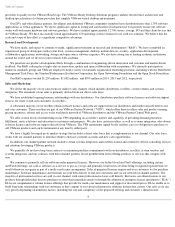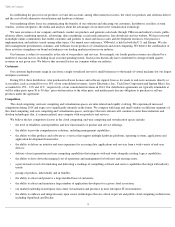VMware 2014 Annual Report Download - page 20
Download and view the complete annual report
Please find page 20 of the 2014 VMware annual report below. You can navigate through the pages in the report by either clicking on the pages listed below, or by using the keyword search tool below to find specific information within the annual report.
Table of Contents
assets and liabilities that we hedge, our hedging transactions may not yield the results we expect. Additionally, we expect to continue to
experience foreign currency gains and losses in certain instances where it is not possible or cost effective to hedge our foreign currency
exposures. For example, we experienced a measurable negative impact to our revenues in the fourth quarter of 2014 due to exchange rate
fluctuations and we expect a further negative impact to 2015 revenues and unearned revenues even if currency exchange rates stabilize. The
further weakening of foreign currency exchange rates against the U.S. dollar would likely result in additional adverse impact on our revenues.
We may not be able to respond to rapid technological changes with new solutions and services offerings, which could have a material
adverse effect on our sales and profitability.
The virtualization, cloud computing, end-user computing and SDDC industries are characterized by rapid technological changes, changing
customer needs, frequent new software product introductions and evolving industry standards. The introduction of third-party solutions
embodying new technologies and the emergence of new industry standards could make our existing and future software solutions obsolete and
unmarketable. Cloud computing is proving to be a disruptive technology that will alter the way that businesses consume, manage and provide
physical IT resources, applications, data and IT services. We may not be able to establish or sustain our thought leadership in the cloud
computing and enterprise software fields, and our customers may not view our products and services as innovative and best-of-breed, which
could result in a reduction in market share and our inability to command a pricing premium over competitor products and services. We may not
be able to develop updated products and services that keep pace with technological developments and emerging industry standards and that
address the increasingly sophisticated needs of our customers or that interoperate with new or updated operating systems and hardware devices
or certify our products and services to work with these systems and devices. As a result, we may not be able to accurately predict the lifecycle of
our software solutions, and they may become obsolete before we receive the amount of revenues that we anticipate from them. There is no
assurance that any of our new offerings would be accepted in the marketplace. Significant reductions in server-related costs or the rise of more
efficient infrastructure management software could also affect demand for our software solutions. As hardware and processors become more
powerful, we will have to adapt our product and service offerings to take advantage of the increased capabilities. For example, while the
introduction of more powerful servers presents an opportunity for us to provide better products for our customers, the migration of servers to
microprocessors with an increasing number of multiple cores also allows an end user with a given number of licensed copies of our software to
multiply the number of virtualization machines run per server socket without having to purchase additional licenses from us. If we are unable to
revise our solutions and offerings in response to new technological developments, our ability to retain or increase market share and revenues in
the virtualization software space could be materially adversely affected.
Our operating results may fluctuate significantly, which makes our future results difficult to predict and may result in our operating results
falling below expectations or our guidance and cause the price of our Class A common stock to decline.
Our operating results may fluctuate due to a variety of factors, many of which are outside of our control. As a result, comparing our
operating results on a period-to-period basis may not be meaningful. Our past results should not be relied upon as an indication of our future
performance. In addition, a significant portion of our quarterly sales typically occurs during the last month of the quarter, which generally
reflects customer buying patterns for enterprise technology. As a result, our quarterly operating results are difficult to predict even in the near
term. If our revenues or operating results fall below the expectations of investors or securities analysts or below any guidance we may provide to
the market, the price of our Class A common stock would likely decline substantially.
In addition, factors that may affect our operating results include, among others:
18
• general economic conditions in our domestic and international markets and the effect that these conditions have on our customers’
capital budgets and the availability of funding for software purchases;
•
fluctuations in demand, adoption rates, sales cycles and pricing levels for our products and services;
•
fluctuations in foreign currency exchange rates;
• changes in customers’
budgets for information technology purchases and in the timing of their purchasing decisions;
•
the timing of recognizing revenues in any given quarter, which, as a result of software revenue recognition policies, can be affected by a
number of factors, including product announcements, beta programs and product promotions that can cause revenue recognition of
certain orders to be deferred until future products to which customers are entitled become available;
•
the sale of our products and services in the time frames we anticipate, including the number and size of orders in each quarter;
• our ability to develop, introduce and ship in a timely manner new products and services and enhancements that meet customer demand,
certification requirements and technical requirements;
























